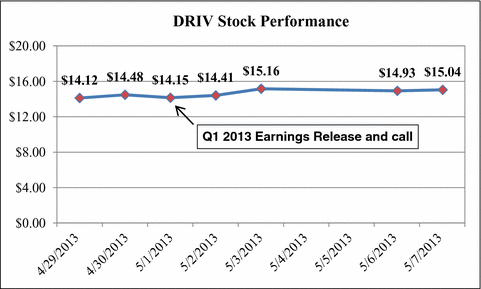
Kevin L. Crudden
Senior Vice President & General Counsel
January 9, 2015
VIA EDGAR AND FACSIMILE
Securities and Exchange Commission
Division of Corporation Finance
100 F Street, NE
Washington, D.C. 20549
Attn: Stephen G. Krikorian, Accounting Branch Chief
Re: Digital River, Inc.
Form 10-K for Fiscal Year Ended December 31, 2013
Filed February 27, 2014
File No. 000-24643
Dear Mr. Krikorian:
On behalf of Digital River, Inc., a Delaware corporation (the “Company”), I am writing in response to your comment letter dated December 23, 2014 (the “Comment Letter”) regarding the Company’s disclosures in its filing identified above.
RESPONSE TO STAFF COMMENTS
The Company acknowledges the Staff’s comments and respectfully submits the following responses. The text of the Staff’s comments has been reproduced below, for your convenience.
Form 10-K for Fiscal Year Ended December 31, 2013
Consolidated Financial Statements
Note 1. Nature of Operations and Summary of Significant Accounting Policies
Reclassifications, page 73
Comment 1. We note your response to prior comment 4 and it remains unclear to us why this was not an error. Your response indicates that you “re-evaluated these costs” but that the change in presentation was not an error. Please explain why payment processing was more of a sales tool rather than part of your ecommerce offering and tell us whether you earned revenue
from payment processing services prior to 2013. Also, please tell us when payment processing became an offering to your ecommerce clients or as a standalone offering. In this regard, it is unclear to us why the reclassification was not reflected in your financial statements until fiscal year 2013.
Response 1. Our payments service offering has evolved over time. As a part of our ecommerce offering, we initially included payment processing as a sales tool to differentiate our ecommerce offering from other ecommerce competitors. In order to expand our payments capabilities in markets outside the U.S., we acquired a company named Netgiro in 2007. Because the Netgiro business included revenue for payment processing outside of Digital River’s ecommerce business, we inherited a small separate revenue stream for payments. In 2011, we hired a payments sales leader, with the intention to grow a stand-alone payments revenue stream. In 2013, we acquired another payments business, which increased our payments revenue stream from 6% to 16% of our total revenue:
2009 $11.2M
2010 $12.7M
2011 $18.0M
2012 $24.9M
2013 $61.5M
It was at this time that management began to focus on payments as a separate service offering. Thus, management concluded that it was more representative to separately discuss payments in our MD&A and reflect the cost of providing that service as a cost of services, rather than sales and marketing expense. Therefore we did not consider the prior period presentation to be an error, but a change in how we view the business. Instead of reflecting those costs only prospectively, we determined that for comparability purposes a retroactive presentation would be more helpful to our investors. Although payments revenue was relatively small until 2013, payment processing costs were higher in the years prior to our change in strategy due to the costs associated with our ecommerce offering:
2009 $56.3M
2010 $43.4M
2011 $48.2M
2012 $50.9M
2013 $61.3M
Although the reclassification of payment processing fees, along with the related chargebacks and certain related personnel expenses, was quantitatively significant, we note neither revenue, operating income, nor net income were impacted by the change because the reclassification is entirely within operating expenses and no measure of gross margin is included in the financial statements. Further, qualitatively, the change made us more comparable to our payments competitors (such as Heartland Payment
2
Systems, Inc., Vantiv, Inc., Optimal Payments PLC, Worldpay Group, and Global Payments, Inc.) which present processing or network fees within cost of services or otherwise separately from sales and marketing.
No covenant or contractual arrangements were impacted and the market and analysts’ reaction to this change was neutral. While some of our analysts appreciated the improved transparency, we noted no meaningful shifts in our ownership or in our stock price as presented in the chart below.

On January 8, 2015, we filed our definitive proxy statement for our proposed merger announced on October 23, 2014. We have scheduled a stockholder meeting for February 12, 2015, which is prior to the due date of our next Form 10-K (March 16, 2015). We expect to file to deregister our shares with the SEC and Nasdaq shortly after the stockholders meeting.
* * * * *
The Company hereby acknowledges that:
· the Company is responsible for the adequacy and accuracy of the disclosure in the filing;
· Staff comments or changes to disclosure in response to Staff comments do not foreclose the Commission from taking any action with respect to the filing; and
3
· the Company may not assert Staff comments as a defense in any proceeding initiated by the Commission or any person under the federal securities laws of the United States.
Please direct any further questions or comments concerning this response letter to me at (612) 260-3050.
| Sincerely, |
| |
| DIGITAL RIVER, INC. |
| |
| |
| By: | /s/ Kevin L. Crudden |
| Kevin L. Crudden, Esq. |
| Senior Vice President and General Counsel |
cc: Morgan Youngwood, Securities and Exchange Commission
David C. Dobson, Chief Executive Officer, Digital River, Inc.
Stefan B. Schulz, Chief Financial Officer, Digital River, Inc.
4
